Centauri Dreams
Imagining and Planning Interstellar Exploration
On Outer System Oceans
Back in the days when I was reading Poul Anderson’s The Snows of Ganymede and thought of the moons of Jupiter as icy wastelands, I never would have dreamed there could be an ocean below their surfaces. But now we have oceans proliferating. Ganymede’s may contain more water than all Earth’s oceans, while Callisto is also in the mix, and we’ve known about Europa for some time now. At Saturn, the case for an ocean inside Titan seems strong, while Enceladus continues to spark mission proposals to study its frequent geysers.
If you’re a Centauri Dreams regular, you know that we’ve talked about Pluto’s oceanic possibilities for some time, now strengthened in new work from Brandon Johnson (Brown University). Johnson and colleagues have modeled an ocean layer on Pluto more than 100 kilometers thick, with a salt content more or less like that of the Dead Sea on Earth. Johnson focused on Sputnik Planum, the 900-kilometer basin that comprises part of the heart-shaped feature we all learned to recognize during last summer’s New Horizons flyby.
The work is helpful because unlike previous studies, it puts constraints on the depth of the ocean and offers information about its composition. Sputnik Planum, as it turns out, sits exactly on the tidal axis linking tidally-locked Charon with Pluto, suggesting that the area has a positive mass anomaly; i.e., there is more mass here than the average for Pluto’s crust.
Thus Charon’s gravity would eventually pull this higher-mass area into the alignment we see. A large impact, like the one that created Sputnik Planum, would eventually be filled with liquid water, and in Johnson’s scenario, nitrogen ice deposited later would tip the scales, creating the positive mass anomaly. “This scenario, says Johnson, “requires a liquid ocean.” And of the various thicknesses of the water layers modeled, 100 kilometers works out best at creating the features we see at Sputnik Planum.
Usefully, the team’s computer models showed that the thickness of the ocean layer could be tied directly to the production of the mass anomaly, which also turns out to be sensitive to the salinity of the water, affecting the water’s density. We can tell a lot from this impact of an object 200 kilometers across or larger and its effects upon an ocean with a salinity of about 30 percent.
“What this tells us is that if Sputnik Planum is indeed a positive mass anomaly —and it appears as though it is — this ocean layer of at least 100 kilometers has to be there,” Johnson says. “It’s pretty amazing to me that you have this body so far out in the solar system that still may have liquid water.”
The Case for Dione
Now we have word of yet another possible ocean, this one on Saturn’s moon Dione. Mikael Beuthe (Royal Observatory of Belgium) and team have been modeling the icy shells of Enceladus and Dione, using gravity data from Cassini flybys. The models study the shells of both moons as global icebergs immersed in water — here surface peaks are held up by a large mass under the water. The approach has not previously proven effective in modeling Enceladus, for it produces a thick crust for the moon that is inconsistent with our observations.
But isostasy, the equilibrium in parts of the Earth’s crust, can be similarly modeled, as blocks floating on the underlying mantle, which rises and falls as material is added or removed. What the researchers have done is to add a new wrinkle:
“As an additional principle, we assumed that the icy crust can stand only the minimum amount of tension or compression necessary to maintain surface landforms,” says Beuthe. “More stress would break the crust down to pieces.”
This revised model works well at producing an ocean for Enceladus under a thinner crust than previous models, with water close enough to the surface to produce the famous geysers at the south pole. The model is also consistent with the libration of Enceladus in its orbit, oscillations that would be smaller if the moon had a thicker crust. Under the same model, Dione is revealed to have a much thicker crust covering a deep ocean between the crust and the moon’s core.
The Cassini data thus become consistent with an ocean about 100 kilometers below the surface of Dione, an ocean perhaps tens of kilometers deep surrounding a large, rocky core. We may be able to test this prediction with future spacecraft in the Saturn system, which may be able to measure the libration of Dione, an oscillation the researchers believe would be well below the detection capabilities of Cassini, but a useful marker as evidence of the subsurface ocean.
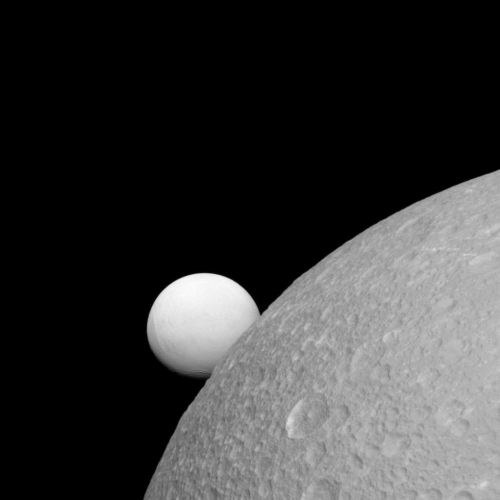
Image: Dione with Enceladus in the background. This image was taken by the Cassini spacecraft on 8 September 2015. Credit: NASA/JPL-Caltech/Space Science Institute.
And what of other outer system objects? From the paper:
Beyond Enceladus and Dione, our new take on isostasy is applicable to large icy satellites
with global oceans, such as Europa [Nimmo et al., 2007b], Titan [Nimmo and Bills,2010], and particularly Ganymede whose gravity and shape will be measured by the JUICE mission. According to Park et al. [2016], gravity and shape data from the Dawn mission suggest isostasy on Ceres, but the case is far from clear because compensation does not occur for all gravity components. Finally, isostasy plays a crucial role in understanding the long-wavelength gravity and shape as well as estimating the crust thickness of the planets Mars [Wieczorek and Zuber , 2004], Venus [James et al., 2013], and Mercury [Perry et al., 2015]. Thanks to the simultaneous availability of gravity/shape and libration data, Enceladus’s case constitutes the first validation of planetary-scale isostasy.
The paper is Beuthe et al., “Enceladus’ and Dione’s floating ice shells supported by minimum stress isostasy,” published online by Geophysical Research Letters 28 September 2016 (abstract / preprint). The paper on Pluto’s ocean is Johnson et al., “Formation of the Sputnik Planum basin and the thickness of Pluto’s subsurface ocean,” Geophysical Research Letters 19 September 2016 (abstract).

System Evolution: Delving into Brown Dwarf Disks
We’ve seen circumstellar disks around numerous stars, significant because it is from such disks that planets are formed, and we would like to know a good deal more about how this process works. Now we have word of planet-forming disks around several low-mass objects that fit into the brown dwarf range, and one small star about a tenth the mass of the Sun. With the brown dwarfs, we’re working with objects small enough to be at the boundary between planet and star.
The work is led by Anne Boucher (Université de Montréal), whose team drew photometric data from the Two-Micron All-Sky Survey (2MASS) and the Wide-field Infrared Survey Explorer (WISE) mission, allowing the detection of the objects at infrared wavelengths. Boucher notes the strong attraction such objects hold for astronomers:
“Finding disks in low-mass systems is really interesting to us, because objects that exist at the lower limit of what defines a star and that still have disks that indicate planet formation can tell us a lot about both stellar and planetary evolution.”
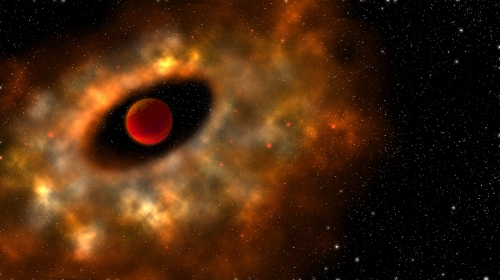
Image: An artist’s conception of a planet-forming disk around a brown dwarf. Credit: Robin Dienel.
But let’s pause for a moment on the nature of the disks themselves. Dusty debris disks are considered to be signs of past planet formation, while gas-rich primordial disks mark the presence of active planet formation and accretion into the host star. Because disks can be detected by the presence of excess infrared, beyond what we would expect from the star by itself, we can use infrared observations to measure the differences in thermal emission from one infant system to another, showing us a range of disks at various stages of their evolution.
Thus we get massive primordial disks that are gas-rich and dense around younger systems, while dusty debris disks are colder and more depleted in gas, marking the remnants of planetary system formation even as they are replenished by the collisions of small objects in the system. These can last up to 100 million years; they’re colder and observable in the mid-infrared (primordial disks produce a strong signature in the near-infrared). We also see so-called ‘transition’ disks with an inner region depleted of dust, and an outer region still rich in it.
What Boucher and colleagues have been looking at are three objects ranging from 13 to 19 Jupiter masses, and a fourth of between 101 and 138 Jupiter masses. The paper makes the case that all four disk candidate stars are members of stellar associations — the TW Hydra, Columba, and Tucana-Horologium associations — allowing the researchers to draw conclusions about their age. A stellar association is a large grouping of stars similar in spectral type and origin, grouped more loosely than open or globular-type star clusters. These are young stars that have not had time to move any great distance from their place of formation.
The four disks are all thought to be in the planet-forming phase, none of them having attained the age of a dusty debris disk. Even so, two of these objects appear older — at between 42 and 45 million years — than we would normally associate with an active disk system. From the paper:
Disk temperatures and fractional luminosities were determined from this analysis. Their values indicate that the new disks are likely transitional or primordial. The spectral types of these new disk hosts are late (M4.5 to L0?), and correspond to low-mass BDs (13 ? 19 and 101 ? 138MJup) of young ages (? 7 ? 13 and ? 38 ? 49Myr). These four systems join a relatively small sample of low-mass objects known to harbor a circumstellar disk. There is still a lot to learn about primordial and (pre-)transitional disks around low-mass stars, and these four new candidates could play an important role to shed light on the formation and evolution processes of stars and planetary systems.
Also in question is the fraction of brown dwarfs that have developed planetary systems. Finding debris disks around young objects like these is one way into the problem, for we can watch the process of planet formation unfold around objects of different ages. Bear in mind as well that their lower luminosity means objects like these could be interesting targets for exoplanet searches using direct imaging methods. All four of the new disk candidates should likewise be prime candidates, the paper suggests, for the Atacama Large Millimeter Array.
The paper is Boucher et al., “BANYAN. VIII. New Low-Mass Stars and Brown Dwarfs with Candidate Circumstellar Disks,” accepted at The Astrophysical Journal (preprint).

Thoughts on Rosetta’s End
A mission as complex as the European Space Agency’s highly successful Rosetta is a compilation of interlocking parts. I always find it fascinating to look at the instrumentation aboard. Take Alice, a UV imaging spectrograph no bigger than a shoebox. Alice weighs in at less than 4 kilograms and draws a meager 4 watts of power, but it offered us a thousand times the data we could retrieve with similar instruments no more than a generation ago.
Alice produced over 70,000 spectra in two years, according to its principal investigator, Alan Stern (a familiar name indeed for those interested in the outer Solar System!) With these data we’re learning about the porous surface of the comet, its lack of exposed water ice, and the unexpected occurrence of molecular hydrogen around it.
Rosetta’s Ion and Electron Spectrometer (IES), likewise the work of the Southwest Research Institute, is another triumph of miniaturization, achieving the sensitivity of instruments weighing five times as much (IES has a mass of about a kilogram). In combination with four other instruments analyzing the plasma environment, the IES examined solar wind interactions with the coma of Comet 67P/Churyumov-Gerasimenko.
For the final images of the Rosetta mission, we leaned on the spacecraft’s OSIRIS wide-angle camera, which captured the scene just before Rosetta made its controlled impact onto the surface on September 30. As expected, the signal from the spacecraft was lost upon impact, but we still coaxed information on cometary gas, dust and plasma out of Rosetta as it descended. All told, 11 science instruments contributed to Rosetta’s abundant reservoir of data.
As with the upcoming end of Cassini’s mission, there is a certain poignancy in Rosetta’s final chapter, though as the comet heads toward the orbit of Jupiter, there would have been too little sunlight to power the mission. Ending its life on the comet it studied seems fitting.

Image: The OSIRIS narrow-angle camera aboard the Space Agency’s Rosetta spacecraft captured this image of comet 67P/Churyumov-Gerasimenko on September 30, 2016, from an altitude of about 16 kilometers above the surface during the spacecraft’s controlled descent. The image scale is about 30 centimeters per pixel and the image itself measures about 614 meters across. Credit: ESA/Rosetta/MPS for OSIRIS Team MPS/UPD/LAM/IAA/SSO/INTA/UPM/DASP/IDA.
And here we have the final image, which reminds me in several ways of the final Huygens image from Titan. In both instances, we have a controlled descent to a surface of huge scientific interest culminating a first-of-its-kind mission, in Rosetta’s case the first spacecraft to orbit and escort a comet on its journey. I’m also reminded of some of the early images from the Moon, such as the photo Ranger 7 took at about 500 meters above Mare Cognitum in 1964.
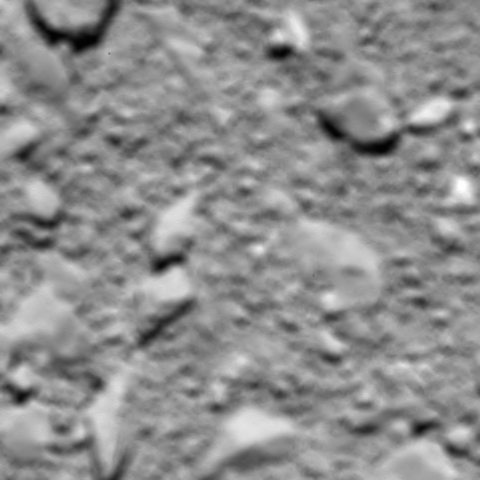
Image: Rosetta’s last image of Comet 67P/Churyumov-Gerasimenko, taken shortly before impact, at an estimated altitude of 66 feet (20 meters) above the surface. The image was taken with the OSIRIS wide-angle camera on 30 September. The image scale is about 5 mm/pixel and the image measures about 2.4 m across. Credits: ESA/Rosetta/MPS for OSIRIS Team MPS/UPD/LAM/IAA/SSO/INTA/UPM/DASP/IDA.
Now, as with New Horizons, we have years worth of data to comb through, with early discoveries an indication of the richness of the datasets. The Rosetta Orbiter Spectrometer for Ion and Neutral Analysis (ROSINA) has demonstrated that comets contain the amino acid glycine, while discovering over 60 molecules at Comet 67P, 34 of which had never been found on a comet, according to André Bieler (University of Bern). Only some 5 percent of the ROSINA data has been analyzed to this point, which means we should have no shortage of future cometary analysis. We’ll also learn more from the Microwave Instrument for Rosetta Orbiter (MIRO) data, examining the behavior of gas and dust as they form the coma.
On the surface of Comet 67P is a 130-meter pit that mission controllers named Deir el-Medina. The reference is fascinating in itself. In the period of the Egyptian 18th to 20th dynasties (roughly 1550-1080 BC), Deir el-Medina (then known as Set Maat, or ‘Place of Truth’) was the village where artisans labored while they worked on the tombs in the Valley of the Kings. Painters and artisans decorated tombs dedicated to helping the spirit find its way in the afterlife.
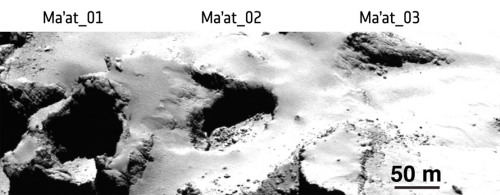
Image: The region called Ma’at, on the smaller of the two lobes of Comet 67P/Churyumov-Gerasimenko. Rosetta targeted a region that is home to several active pits measuring over 100 m wide and over 50 m deep, with the hope of getting some close-up glimpses of these features. The large, well-defined pit adjacent to the target site and identified in the image above as Ma’at 02 has now been named by the mission team ‘Deir el-Medina,’ after a pit in an ancient Egyptian town of the same name that was home to many of the workers who built the pharaoh tombs in the Valley of the Kings. Credit: ESA/Rosetta/MPS for OSIRIS Team MPS/UPD/LAM/IAA/SSO/INTA/UPM/DASP/IDA.
Cometary terrain adjacent to the Deir el-Medina region on Comet 67P is now Rosetta’s final resting place. The connection with an ancient village and key archaeological site is somehow fitting, as we connect our deepest impulses of exploration with our earliest attempts to probe the riddle of existence. The thought that human technology now rides a comet deep into the Solar System is a spur, goading us to reach out again, as we have so often done, into the unknown.

Time Out
No Centauri Dreams posts this week — I’ll be back next Monday. I’ve been running hard and it’s time for a break. I’ll keep up with comment moderation as best I can, though I’m going to be trying to catch up with many long overdue commitments outside the interstellar field in coming days. As always, thanks to all for the continuing support. See you soon!

Circumbinary Planet Found in Microlensing Data
A circumbinary planet is one that orbits two stars, and to date we haven’t found many of them. Word of a new detection comes from an event observed back in 2007 during a microlensing study called OGLE — Optical Gravitational Lensing Experiment. OGLE is a Polish undertaking designed to study dark matter using gravitational microlensing, but while dark matter remains as dark as ever, the project has been able to deliver useful findings on distant exoplanets.
A number of groups specializing in gravitational microlensing also contributed to this analysis. These are observation efforts not as well known to the public as Kepler or Gaia, but they’re doing exceptional work: MOA (Microlensing Observations in Astrophysics); MicroFUN (Microlensing Follow-Up Network); PLANET (Probing Lensing Anomalies NETwork); and Robonet. Subsequent Hubble Telescope data were then applied to the analysis, confirming the discovery.
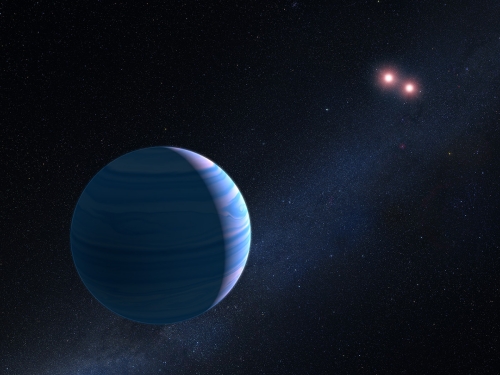
Image: This artist’s illustration shows a gas giant planet circling a pair of red dwarf stars. The Saturn-mass planet orbits roughly 480 million kilometers from the stellar duo. The two red dwarf stars are a mere 11 million kilometers apart. The illustration is based on Hubble Space Telescope observations that helped astronomers confirm the existence of a planet orbiting two stars in the system OGLE-2007-BLG-349, located 8,000 light-years away. Credit: NASA, ESA, and G. Bacon (STScI).
The distance of the stars in question — some 8000 light years away in the direction of galactic center — raises the issue of microlensing’s unique capabilities. Gravitational microlensing happens when a foreground star moves in front of a background star, causing the gravity of the former to ‘bend’ the light of the latter. The ‘bending’ is actually the light following the curvature of spacetime caused by the foreground star’s gravitational field, but whatever we call it, gravitational microlensing can help us detect planets that would otherwise be lost to us, for how the light is magnified offers many clues to the foreground star and any possible planets.
Both radial velocity and transit methods detect planets most readily when they are near to their star. A planet orbiting close in makes multiple transits in a shorter period of time than one further out, which is why the early Kepler detections were of planets like this, with the boundary of detection gradually moving outward with time. Radial velocity, which looks at the Doppler shift of light from the star as it is tugged by the orbiting planet, likewise shows its strongest signal for a close-in, large planet, and that’s why we had so many early detections of ‘hot Jupiters.’
But gravitational microlensing is another thing entirely, capable of finding planets and stars at a wide range of orbital distances around stars that can be many thousands of light years away. The OGLE-2007-BLG-349 event produced a light curve that needed additional data from the Hubble Space Telescope to confirm, allowing astronomers to separate the background source star and the lensing star in the crowded starfield.
What we wind up with is a planet orbiting about 480 million kilometers from its host stars, both of them red dwarfs no more than 11 million kilometers apart. David Bennett (NASA GSFC), lead author on the paper discussing the discovery, describes the process used in the work:
“The ground-based observations suggested two possible scenarios for the three-body system: a Saturn-mass planet orbiting a close binary star pair or a Saturn-mass and an Earth-mass planet orbiting a single star… [T]he model with two stars and one planet is the only one consistent with the Hubble data. We were helped in the analysis by the almost perfect alignment of the foreground binary stars with the background star, which greatly magnified the light and allowed us to see the signal of the two stars.”
Unlike Kepler’s ten discovered circumbinary planets, the two orbiting OGLE-2007-BLG-349 are much further away from their hosts. The paper discusses another two-star plus one planet event that has been interpreted as a planet orbiting one of the two stars (OGLE-2013-BLG-0341), and a second event dominated by a stellar binary signal, adding:
This suggests that there should be many more two-star plus one planet events in the data that we have already collected, but that we are not efficient at finding planetary signals in events that are dominated by stellar binary microlensing features. So, we recommend a systematic search for planetary signals in the light curves of strong stellar binary events.
As you might expect, the paper for today has a long list of co-authors. It’s Bennett et al., “The First Circumbinary Planet Found by Microlensing: OGLE-2007-BLG-349L(AB)c,” accepted at The Astronomical Journal and available as a preprint.

Stormy ‘Space Weather’ for M-dwarf Planets?
Proxima Centauri b, that highly interesting world around the nearest star, is about 0.05 AU out from its primary. The figure leaps out to anyone new to red dwarf stars, because it’s so very close to the star itself, well within the orbit of Mercury in our own system. But these are small, dim stars compared to our Sun, and hugging the star is essential to remain in the habitable zone. That also makes for very short years — Proxima b completes an orbit every 11.2 days.
Guillem Anglada-Escudé and colleagues reminded us in the discovery paper that among the many things we have to ask about this planet is whether or not it has a strong magnetic field. Because Proxima Centauri is known for flare activity, not to mention 400 times the X-ray flux the Earth receives. A magnetic field could help the planet hang on to its atmosphere, but just how strong would it need to be? Like any M-dwarf planet, then, Proxima b seems vulnerable.
This thinking has ramifications much closer to home. We are learning that CMEs have influenced the atmosphere of Mars and may have played a large role in how it evolved. Data from the Mars Atmosphere and Volatile Evolution (MAVEN) spacecraft point in this direction, showing that a CME can compress the Martian magnetosphere, spinning off effects in the ionosphere and below. We are now in the realm of what is being called ‘space weather.’
Think about what happens here on Earth when the Sun throws off one of its enormous storms, a coronal mass ejection, or CME. Outflowing plasma can thoroughly disrupt communications and navigation equipment, with damage to satellites and even power blackouts, all this with our own planet’s magnetic field around us. And although stars like Proxima Centauri are much smaller than ours, it turns out that they are far more active, with CMEs often ten times more powerful.
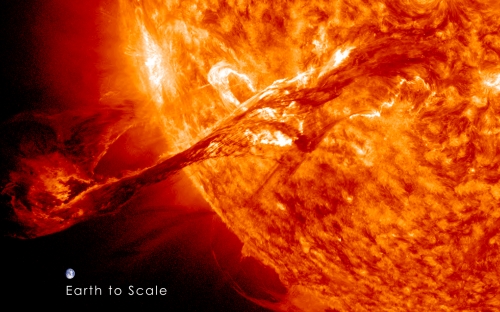
Image: On August 31, 2012 a long filament of solar material that had been hovering in the sun’s atmosphere, the corona, erupted out into space at 4:36 p.m. EDT. The coronal mass ejection, or CME, traveled at over 1450 kilometers per second. The CME did not travel directly toward Earth, but did connect with Earth’s magnetic environment, or magnetosphere, with a glancing blow. causing aurora to appear on the night of Monday, September 3. Credit: NASA GSFC.
Add into the mix the fact that M-dwarfs can maintain high levels of magnetic activity for billions of years. Although Proxima Centauri is thought to be roughly the age of the Sun, about five billion years, it is clearly an active star. All of this is troubling for the prospects for astrobiology.
Now we have new work led by Christina Kay (NASA GSFC and Boston University) that makes an intriguing case. The probability of a habitable zone planet around an M-dwarf being hit by a CME may depend on the plane of the planet’s orbit. The work revolves around modeling of coronal mass ejections from the M-dwarf V374 Peg, allowing Kay and team to assess the effects of CMEs on a planet in the star’s habitable zone. The model is called Forecasting a CME’s Altered Trajectory (ForeCAT), and it predicts how a CME can wind up being deflected.
Now we get into interesting territory, for these models show that CME’s move in particular directions when deflected by the star’s magnetic field. A key factor here is what is known as the Astrospheric Current Sheet, which is the location of the minimum level of the background magnetic field. A strong magnetic field like that of V374 Peg can trap a CME at the Astrospheric Current Sheet, with the deflection depending primarily on the CME mass but also on its speed.
ForeCAT was used to analyze these interactions both in the case of a planet in the habitable zone of V374 Peg as well as a hot Jupiter orbiting a Sun-like star. The paper describes an intriguing result:
For both habitable zone mid-type M dwarf exoplanets and hot Jupiters [orbiting solar-type hosts] the probability of impact decreases if the exoplanet’s orbit is inclined with respect to the Astrospheric Current Sheet. The sensitivity to the inclination is much greater for the mid-type M dwarf exoplanets due to the extreme deflections to the Astrospheric Current Sheet. For low inclinations we find a probability of 10% whereas the probability decreases to 1% for high inclinations.
In other words, planetary orbits that line up with the astrospheric current sheet, which is generally aligned with the star’s equator, have a higher probability of being hit by a CME than planets in higher-inclination orbits. All of this has significant potential for affecting habitability:
From our estimation of 50 CMEs per day, we expect habitable mid-type M dwarf exoplanets to be impacted 0.5 to 5 times per day, 2 to 20 times the average at Earth during solar maximum. The frequency of CME impacts may have significant implications for exoplanet habitability if the impacts compress the planetary magnetosphere leading to atmospheric erosion.
At stake here is the minimum planetary magnetic field needed to retain an atmosphere (Kay and team believe a magnetosphere twice the size of the planetary radius is necessary). For mid-type M-dwarfs like V374 Peg, magnetic fields between tens to hundreds of Gauss are required to protect an exoplanet in the habitable zone. This is one to two orders of magnitude more than that of the Earth. The conclusion is stark: “We expect that rocky exoplanets cannot generate sufficient magnetic field to shield their atmosphere from mid-type M dwarf CMEs.”
The good news: The scientists argue that the minimum magnetic field strength will change depending on the M-dwarf’s spectral type, as well as on stellar activity and stellar magnetic field strength changes. Some types of M-dwarf may thus be more likely to retain an atmosphere than dwarfs like V374 Peg. Extending this work in their direction is a compelling next step.
The paper is Kay et al., “Probability of CME Impact on Exoplanets Orbiting M Dwarfs and Solar-Like Stars,” Astrophysical Journal Vol. 826, No. 2 (abstract / preprint). An AAS Nova essay on this work is also available.


